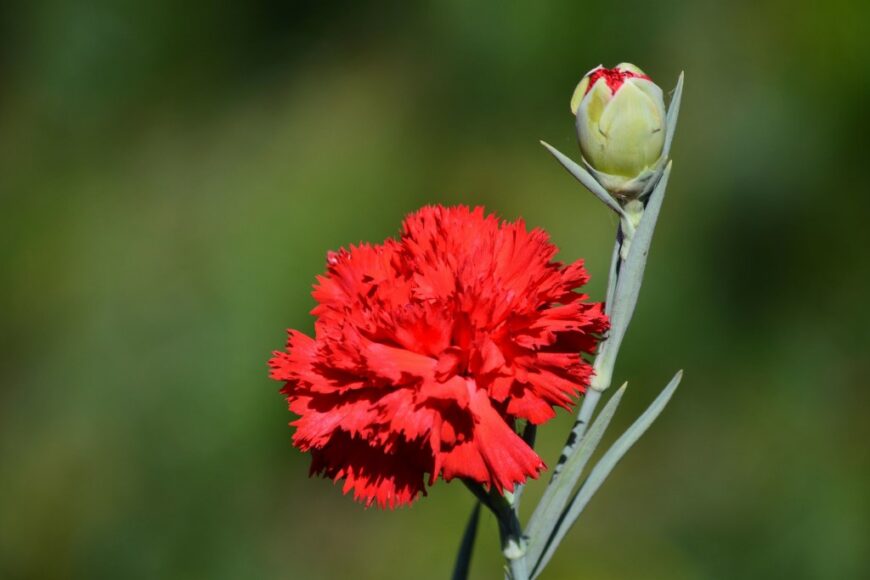
 Name: Carnation
Name: Carnation Family: Caryophyllaceae
Family: Caryophyllaceae Origins: Mediterranean region
Origins: Mediterranean region Humidity: Prefers moderate humidity levels but can tolerate dry conditions.
Humidity: Prefers moderate humidity levels but can tolerate dry conditions. Location: Full sun to partial shade.
Location: Full sun to partial shade. Soil: Well-drained, fertile soil with a slightly alkaline to neutral pH.
Soil: Well-drained, fertile soil with a slightly alkaline to neutral pH. Pests and diseases: Common pests include aphids, slugs, and snails. Common diseases include fungal diseases, stem rot, and bacterial wilt.
Pests and diseases: Common pests include aphids, slugs, and snails. Common diseases include fungal diseases, stem rot, and bacterial wilt. Care: Height of growth: Water regularly, especially during hot weather. Fertilize every 2-3 weeks with a balanced fertilizer. Deadhead spent flowers to encourage reblooming. Pinch back the tips of young plants to promote bushier growth.
Care: Height of growth: Water regularly, especially during hot weather. Fertilize every 2-3 weeks with a balanced fertilizer. Deadhead spent flowers to encourage reblooming. Pinch back the tips of young plants to promote bushier growth. Planting in the soil: Carnations can grow anywhere from 12 to 24 inches tall, depending on the variety.
Planting in the soil: Carnations can grow anywhere from 12 to 24 inches tall, depending on the variety. Plant carnations outdoors after the last frost date. Space plants 12-18 inches apart, depending on the variety. Water deeply after planting.
Plant carnations outdoors after the last frost date. Space plants 12-18 inches apart, depending on the variety. Water deeply after planting. Blooming: Carnations typically bloom from late spring to early fall.
Blooming: Carnations typically bloom from late spring to early fall.Carnations, scientifically known as Dianthus, are enchanting flowering plants that have captivated gardeners and flower enthusiasts for centuries. With a rich history and a wide array of colors, these perennial beauties are a joy to cultivate. As a seasoned botanist with two decades of experience, I delve into the intricacies of planting and caring for carnations.
Content:
Unveiling the Diversity of Dianthus
Varieties of Carnations
Dianthus encompasses a diverse family, including the popular garden carnations (Dianthus caryophyllus), sweet William (Dianthus barbatus), and pinks (Dianthus plumarius). Each variety boasts unique characteristics, from bloom size to fragrance, making it essential to choose the right type for your garden.
Colors and Symbolism
Carnations are celebrated for their vibrant hues, from classic whites and pinks to bold reds and purples. Beyond aesthetics, these colors often carry symbolic meanings. For instance, white carnations symbolize purity, while red ones convey love and admiration.
Planting Carnations: A Step-by-Step Guide:
Choosing the Right Location
Sunlight Requirements
Carnations thrive in well-lit areas, requiring at least 6 hours of sunlight per day. Plant them in a location with good air circulation to prevent common fungal diseases.
Soil Preparation
Ensure well-draining soil with a slightly alkaline pH (6.0-6.5). Amend the soil with organic matter to enhance fertility and water retention.
Propagation Methods
Seeds vs. Cuttings
While seeds offer a cost-effective option, many prefer cuttings for faster results. Take 4-6 inch cuttings from healthy plants and root them in a well-prepared soil mix.
Ideal Planting Time
Plant carnations in early spring or fall to allow them to establish before extreme temperatures. This timing promotes robust root development and healthier plants.
Watering and Feeding
Watering Schedule
Maintain consistent soil moisture, allowing the top inch to dry between waterings. Overwatering can lead to root rot, while underwatering hampers growth.
Fertilization Routine
Use a balanced fertilizer during the growing season. Apply it every 4-6 weeks to provide essential nutrients for vigorous foliage and prolific blooming.
Pruning Techniques
Deadheading
Remove spent flowers regularly to encourage continuous blooming and prevent seed formation. This practice redirects the plant’s energy toward new growth.
Thinning
Thin crowded stems to enhance air circulation, reducing the risk of diseases like powdery mildew. Prune damaged or dead stems for overall plant health.
Floral Arrangements
Carnations are popular choices for cut flower arrangements due to their long-lasting blooms. Incorporate them into bouquets and centerpieces for a touch of elegance.
Medicinal and Culinary Uses
Explore the lesser-known realms of Dianthus. Some cultures use carnations in traditional medicine, citing anti-inflammatory properties. Additionally, certain varieties are edible and add a unique flavor to culinary creations.
Frequently Asked Questions (FAQs)
Q1: Can I grow carnations indoors?
A1: While carnations prefer outdoor cultivation, some smaller varieties can thrive in well-lit indoor spaces.
Q2: How do I combat common pests and diseases?
A2: Keep an eye out for aphids and spider mites. Neem oil or insecticidal soap can help, and proper spacing reduces the risk of fungal diseases.
Q3: Are carnations deer-resistant?
A3: Yes, carnations are generally deer-resistant due to their fragrance and taste.
Conclusion
Cultivating carnations is a rewarding journey that extends beyond aesthetic pleasures. Armed with this comprehensive guide, both novice and experienced gardeners can nurture thriving carnations and appreciate the myriad facets of this botanical treasure.

